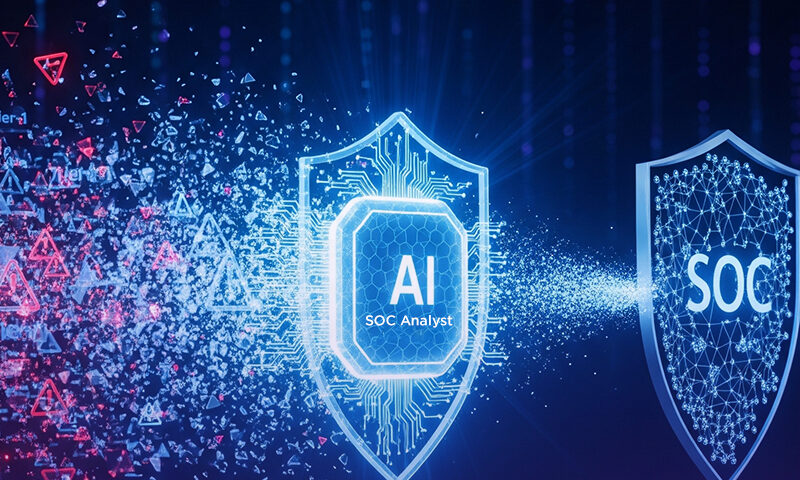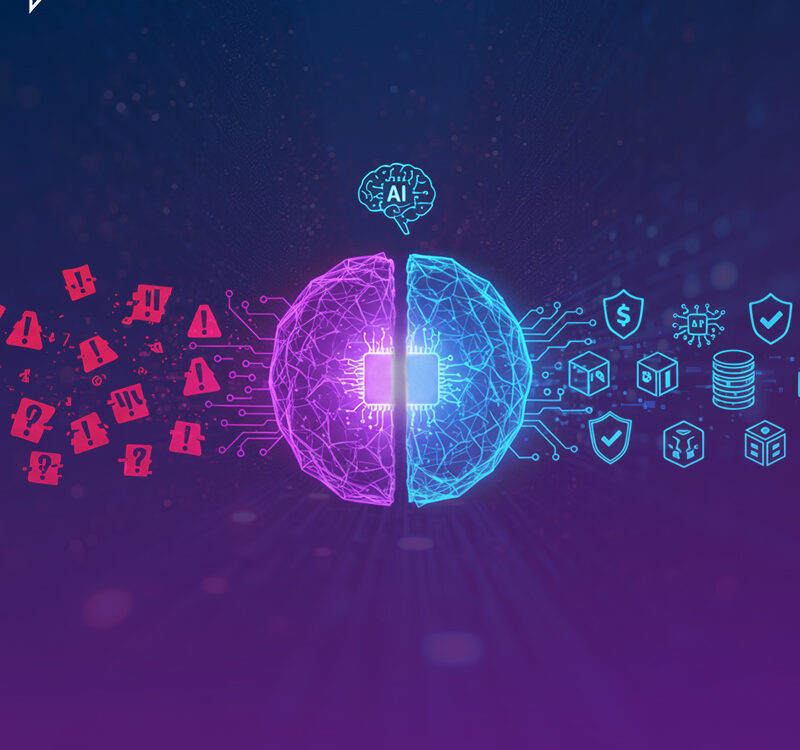
Inside the AI Mesh: How SIRP’s Triage Agents Eliminate Manual Noise at Scale
July 15, 2025
Why Traditional SOAR Is Broken – and How the Agentic Mesh Fixes It
July 23, 2025
Inside the AI Mesh: How SIRP’s Triage Agents Eliminate Manual Noise at Scale
July 15, 2025
Why Traditional SOAR Is Broken – and How the Agentic Mesh Fixes It
July 23, 2025Table of contents
- You Can’t Defend Dynamic Threats with Static Systems
- Why “Self-Evolving” Isn’t a Buzzword - It’s a Requirement
- OmniSense™: The Intelligence Fabric of the Modern SOC
- OmniSense Core: Modular Agents in an Agentic Mesh
- OmniSec LLM: A Language Model That Speaks Security Natively
- OmniFlex: The Reflex Layer That Learns from Outcomes
- OmniMap: A Living Memory Graph of the SOC
- OmniCollective: Federated Learning Across the Ecosystem
- What Self-Evolving Looks Like in Practice: The Phishing Example
- What Changes for Security Teams
- Final Thoughts: From Automation to Intelligence
You Can’t Defend Dynamic Threats with Static Systems
Cybersecurity has evolved. Attackers move faster, coordinate better, and continuously adapt their techniques. Yet most security operations centers (SOCs) are still built on rigid playbooks, brittle automation, and human-intensive triage models that can’t keep up with the pace of modern threats.
Legacy SOAR platforms automate tasks, but they don’t adapt. Most “AI-powered” solutions surface summaries, not decisions. Detection pipelines remain linear in a world where attackers operate laterally, stealthily, and contextually. The result is a fundamental mismatch between how attacks happen and how SOCs are structured to respond.
SIRP wasn’t built to incrementally improve this outdated model. It was built to replace it entirely.
Why “Self-Evolving” Isn’t a Buzzword - It’s a Requirement
The idea of a self-evolving SOC isn’t about chasing hype - it’s about survival in an environment where threats outpace prebuilt logic.
Most systems today require humans to manually encode rules for every known threat pattern. This approach might reduce false positives in the short term, but it collapses under scale, novelty, and change. The moment a campaign deviates even slightly from known behavior, the system either fails silently or escalates to human analysts - further contributing to alert fatigue.
A self-evolving architecture solves this by embedding learning into the fabric of the SOC. It continuously improves from experience, adapts its containment strategies based on feedback, correlates new signals against previously unseen patterns, and learns not just locally but collectively - across deployments - without violating data privacy.
This isn’t about automation. This is about operational intelligence that improves with every incident it touches.
OmniSense™: The Intelligence Fabric of the Modern SOC
At the heart of SIRP’s self-evolving architecture is OmniSense™, a five-layer AI-native innovation stack that acts as the SOC’s decision system, memory layer, feedback engine, and knowledge graph - all working together within an agentic mesh.
Each layer serves a distinct purpose, yet functions as part of a unified whole. Together, they enable modular AI agents to think, collaborate, and evolve over time.
OmniSense Core: Modular Agents in an Agentic Mesh
The foundation of SIRP’s architecture is a network of lightweight, modular AI agents. Each agent is designed to perform a small, well-defined task - whether that’s triaging an alert, enriching context, correlating with past incidents, or suggesting remediation actions.
These agents operate within an intelligent mesh, coordinated in real time, with shared access to context and state. They are stateless, loosely coupled, and independently upgradable - allowing the system to evolve without monolithic redesigns.
This agentic mesh is what replaces the static playbook. It is dynamic, composable, and designed to respond to novel scenarios without waiting for manual updates.
OmniSec LLM: A Language Model That Speaks Security Natively
OmniSec is SIRP’s domain-specific large language model, built and fine-tuned on real-world SOC knowledge - from CVEs and MITRE mappings to analyst case notes, IR timelines, and remediation strategies.
Unlike generic LLMs, OmniSec understands the language of security operations. It allows agents to interpret alerts, summarize incidents, infer intent, and explain actions in natural language - all grounded in context.
Rather than generating hallucinated responses, it delivers reasoning that reflects how real analysts think.
OmniFlex: The Reflex Layer That Learns from Outcomes
OmniFlex is the reinforcement learning layer that governs how agents improve over time. Every action taken by an agent - whether accepted, overridden, or escalated - feeds back into its policy engine.
If a remediation action resolves the incident effectively, that path is reinforced. If an alert classification is reversed by an analyst, the agent’s future decisions adapt accordingly.
OmniFlex ensures the system doesn’t just act - it reflects, refines, and evolves.
OmniMap: A Living Memory Graph of the SOC
OmniMap is SIRP’s contextual memory layer - a continuously updated knowledge graph that maps relationships between users, assets, alerts, behaviors, and historical incidents.
It enables agents to reason over time and topology. For example, a login anomaly can be correlated with lateral movement detected days earlier, or an access spike linked to a dormant asset.
With OmniMap, agents don’t just react to isolated alerts. They understand how those alerts relate to the broader attack landscape.
OmniCollective: Federated Learning Across the Ecosystem
OmniCollective is the layer that enables secure, privacy-preserving intelligence sharing across SIRP deployments.
Rather than centralizing raw data, the system aggregates insights and patterns abstracted from thousands of incidents - allowing every customer to benefit from global learning without sacrificing confidentiality.
Through OmniCollective, the entire platform gets smarter with every incident - regardless of where it happens.]
What Self-Evolving Looks Like in Practice: The Phishing Example
Phishing remains one of the most exploited attack vectors - and one of the hardest to generalize. Traditional SOAR playbooks rely on static checks like SPF/DKIM validation or domain reputation scores. But attackers evolve faster than logic can be updated, and playbooks often fail silently when conditions shift.
SIRP’s self-evolving architecture handles phishing with a coordinated sequence of specialized AI agents operating in real time.
When a suspicious email is detected, HeaderCracker parses metadata fields like SCL, BCL, SPF, DKIM, and CIP. ArtifactExtractor pulls out embedded links, attachments, and QR codes, which are detonated in a sandbox by AutoForensIQ. BehaviorLens analyzes the resulting behavior tree for signs of malware or obfuscation techniques.
From there, IOC Enricher enriches every extracted indicator with threat intelligence. Verified, high-confidence IOCs are pushed directly to enforcement controls by IOC Pusher, blocking the threat across endpoints, email, and DNS.
Meanwhile, OmniMap connects the incident to similar phishing campaigns observed elsewhere in the environment, and FlashBrief generates a full summary for analysts and executives.
Finally, OmniFlex uses the outcome to improve the system. If the response was effective, agent policies are reinforced. If escalated, future decision-making is adapted accordingly.
All of this happens in under 2 minutes - without a playbook, without a queue, and without needing to ask an analyst what to do next.
What Changes for Security Teams
In a self-evolving SOC, analysts don’t waste time manually triaging repetitive alerts or fine-tuning static rules. Instead, they guide the system - approving decisions, escalating exceptions, and shaping policy through feedback.
This model doesn’t remove the analyst from the equation. It elevates their role from responder to strategist.
The system doesn’t just offload work. It becomes a junior SOC team that trains itself under the guidance of your senior analysts.
Final Thoughts: From Automation to Intelligence
OmniSense doesn’t automate what you already know. It learns what you haven’t seen yet.
It’s not a copilot, a plugin, or another tool in your stack. It’s the intelligence layer that transforms your SOC from a reactive queue to a coordinated, learning, and adaptive system.
This is what a self-evolving architecture looks like - modular, context-aware, agentic, and built to improve every day.
Most platforms promise speed. SIRP delivers evolution.




